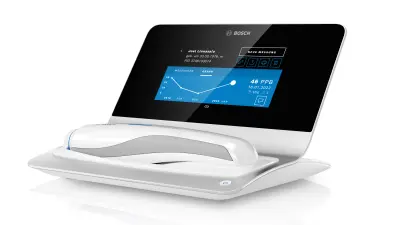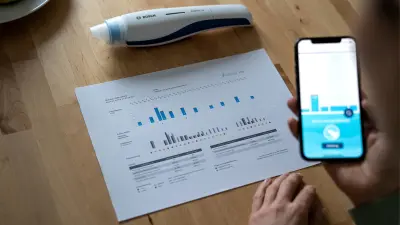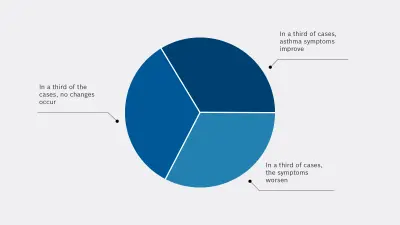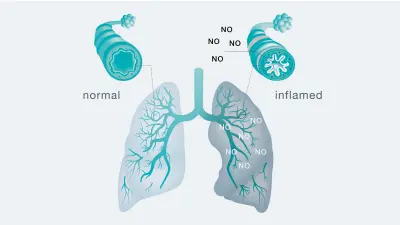The Vivatmo system by Bosch
The first and only FeNO monitoring system connecting physicians and patients for individual, need-based therapy
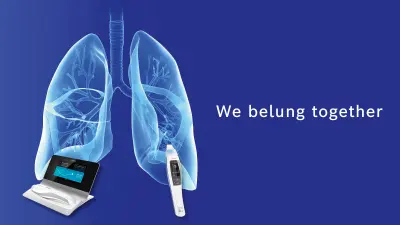
Vivatmo – system overview
Worldwide unique combination: FeNO in medical practice & FeNO at home

FeNO measurement can significantly improve the diagnosis and therapy of asthma – this is evident from numerous studies, guidelines and case reports. Bosch Vivatmo measures the biomarker FeNO in exhaled breath simply and precisely. The Vivatmo system consist of:
- Vivatmo pro – maintenance-free FeNO measurement device for use in practice and clinic
- Vivatmo me – the world's only FeNO home measurement device for patients and studies
- Vivatmo app – asthma diary for patient’s FeNO values and other relevant asthma data
- Vivatmo oxycap – disposable mouthpieces to ensure maximum hygiene and reliable results
Ideal duo: point-of-care and home measurement


What makes Vivatmo special?
The maintenance-free FeNO system connecting physicians and patients for better asthma management
Holistic system approach
Worldwide unique combination: FeNO in medical practice & FeNO at home for individual, need-based therapy in dialogue with the patient – for precise medication, better control of adherence and exacerbations.
Exceptional cost-efficiency
The Vivatmo system requires no recalibration, maintenance, or sensor exchange during the entire lifetime due to high-precision Bosch technology made in Germany.
Flexible operation
Portable, wireless handheld allows mobile measurements. Data is subsequently transmitted to Vivatmo app or basestation via Bluetooth.
Vivatmo pro – for medical practice and clinic
Benefits of Vivatmo pro
Higher throughput and seamless integration into daily routines
Exceptionally cost-efficient system requiring no recalibration, maintenance, or sensor exchange during the entire lifetime (up to 5000 measurement trials) due to high-precision Bosch technology made in Germany.
- Ergonomics similar to playing a flute: Patient exhales against light pressure through the mouthpiece into the handheld.
- Two measurement modes: 10 seconds for adults and 6 seconds for children (7-11 years).
- Two visualizations available to guide the user quickly and intuitively through the measurement maneuver.
- FeNO values available right after the measurement.
- If first attempt fails, Vivatmo pro is ready to measure again within 10 seconds.
- Winner of the Red Dot Design Award.
- Remote software updates available via Vivasuite connectivity solution.
- Common interfaces and data exchange standards enable seamless IT integration: Wifi, USB, Ethernet, HL7, and GDT.
- Patient data management system of up to 10,000 patient files, including export function and immediate printing.
- Backups and optional user login to support data security in clinical environment.
- Portable handheld can perform stand-alone measurements when not paired to basestation. Data is subsequently transmitted via Bluetooth.
- Reduced infection risk due to easy cleaning, no inhalation through device, and highly efficient germ filter in disposable mouthpiece.
- Cleaning with alcohol disinfectant wipes (max. 30%).
- Bacterial filtration efficiency (BFE): 99.998%.
- Viral filtration efficiency (VFE): 99.960%.
The entire Vivatmo system is climate-neutral through carbon offsets.
How does the FeNO measurement work?

Loading the video requires your consent. If you agree by clicking on the Play icon, the video will load and data will be transmitted to Google as well as information will be accessed and stored by Google on your device. Google may be able to link these data or information with existing data.
Whether in medical practice or at home: FeNO measurement always works the same way – fast, simple, repeatable and not stressful. The video shows the procedure on the Vivatmo me patient device: The user exhales consistently through the mouthpiece into the handheld. After successful measurement, the result is immediately available.
What is FeNO?
Vivatmo oxycap for optimal hygiene
The Vivatmo oxycap is a high-quality disposable mouthpiece. It contains several complex filter layers. These reliably trap unwanted particles, bacteria, viruses and moisture before the breath reaches the measuring device. In this way, the mouthpiece optimally prepares the breath sample for the measurement process and ensures that the Vivatmo device remains clean and hygienic inside (BFE/VFE > 99.9%). Thanks to the natural ergonomics, using Vivatmo feels like playing the flute.

This website contains general product information about the Vivatmo system from Bosch. Not all products and their functions mentioned here are approved in every regional market. For a detailed description of the products and features as well as information on intended and safe use, please refer to your locally authorized Bosch distribution partner and the instructions for use that are valid for your country.

